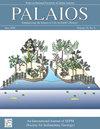侏罗纪棘皮动物膈膜中的凸膜
IF 1.5
4区 地球科学
Q2 GEOLOGY
引用次数: 0
摘要
从古生代和中生代的几个类群的膈膜中可以了解到复杂的三维凸膜系统。这些膜的起源和功能仍然是个谜,由于现代头足类中没有相同的结构,对它们的研究也变得复杂起来。目前有关凸膜和膈膜其他有机结构起源的假说主要是基于对古生代、三叠纪和白垩纪芒柄类动物的研究。本文研究的是亚寒带侏罗纪腕足动物的腕膜。这些膜的空间排列和复杂程度与之前描述的不同。以前人们认为,三维膜只出现在类鹦鹉螺本体的晚期,即新生阶段的末期。然而,在本文研究的棘皮动物中,从第二膈腔开始就出现了这种膜。除了膜之外,我们还报告了侏罗纪类鹦鹉螺的其他最初的有机膈腔结构:假缝和拖线。在一个标本的最后一个膈腔中发现了一种独特的结构,它很可能代表了一组假缝化石,这使我们提出了一个新的假说,它可以解释所有类型的膜和其他最初的有机膈腔结构的形成。根据这一观点,所有类型的凸膜尽管形状各异,但都是在有机假隔膜合并和随后脱水的过程中形成的。伪缝合线和拖曳线是伪膜边缘的印记。本文章由计算机程序翻译,如有差异,请以英文原文为准。
CAMERAL MEMBRANES IN THE PHRAGMOCONES OF JURASSIC AMMONITES
A complex system of three-dimensional cameral membranes is known from the phragmocones of several ammonoid genera—both Paleozoic and Mesozoic. The origin and functions of these membranes remain mysterious, and their study is complicated by the absence of identical structures in modern cephalopods. Current hypotheses about the origin of cameral membranes and other organic structures of the phragmocone are mainly based on the study of Paleozoic, Triassic, and Cretaceous ammonoids. This paper examines the membranes of Subboreal Jurassic ammonites. The spatial arrangement and complexity of these membranes differ from those described earlier. It was previously assumed that three-dimensional membranes only appeared late in ammonoid ontogeny, at the end of the neanic stage. However, in the ammonites studied herein, such membranes are present starting from the second phragmocone chamber. In addition to membranes, we report other initially organic phragmocone structures of Jurassic ammonites: pseudosutures and drag lines. The discovery of a unique structure in the last phragmocone chamber of one specimen, which likely represents a fossilized set of pseudosepta, has led to a new hypothesis, that can explain the formation of all types of membranes and other initially organic phragmocone structures. According to this idea, all types of cameral sheets despite their different shapes, were formed during merging and subsequent dehydration of organic pseudosepta. Pseudosutures and drag lines are imprints of the pseudosepta margins.
求助全文
通过发布文献求助,成功后即可免费获取论文全文。
去求助
来源期刊

Palaios
地学-地质学
CiteScore
2.80
自引率
12.50%
发文量
40
审稿时长
6 months
期刊介绍:
PALAIOS is a monthly journal, founded in 1986, dedicated to emphasizing the impact of life on Earth''s history as recorded in the paleontological and sedimentological records. PALAIOS disseminates information to an international spectrum of geologists and biologists interested in a broad range of topics, including, but not limited to, biogeochemistry, ichnology, paleoclimatology, paleoecology, paleoceanography, sedimentology, stratigraphy, geomicrobiology, paleobiogeochemistry, and astrobiology.
PALAIOS publishes original papers that emphasize using paleontology to answer important geological and biological questions that further our understanding of Earth history. Accordingly, manuscripts whose subject matter and conclusions have broader geologic implications are much more likely to be selected for publication. Given that the purpose of PALAIOS is to generate enthusiasm for paleontology among a broad spectrum of readers, the editors request the following: titles that generate immediate interest; abstracts that emphasize important conclusions; illustrations of professional caliber used in place of words; and lively, yet scholarly, text.
 求助内容:
求助内容: 应助结果提醒方式:
应助结果提醒方式:


